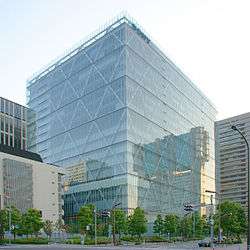History of Sony
Japanese multinational conglomerate Sony has a history stretching back to 1946.
Founding
On 7 May 1946, after the end of World War II, Masaru Ibuka started a radio repair shop in a bomb-damaged Shirokiya department store building in the Nihonbashi district of Tokyo. The next year, he was joined by his colleague, Akio Morita, and they founded a company called Tokyo Tsushin Kogyo[1] (Tokyo Telecommunications Engineering Corporation). The company built Japan's first tape recorder, called the Type-G.[1]
In the early 1950s, Ibuka traveled in Asia and heard about Bell Labs' invention of the transistor.[1] He convinced Bell to license the transistor technology to his Japanese company. While most Japanese companies were researching the transistor for its military applications, Ibuka and Morita looked to apply it to communications. Although the American companies Regency Electronics and Texas Instruments built the first transistor radio as joint venture, it was Ibuka's company that made them commercially successful for the first time.[2]
Early radios
In August 1955, Tokyo Tsushin Kogyo released the Sony TR-55, Japan's first commercially produced transistor radio.[3] They followed up in December of the same year by releasing the Sony TR-72, a product that won favor both within Japan and in export markets, including Canada, Australia, the Netherlands and Germany. Featuring six transistors, push-pull output and greatly improved sound quality, the TR-72 continued to be a popular seller into the early sixties.
In May 1956, the company released the TR-6, which featured an innovative slim design and sound quality capable of rivaling portable tube radios. The following year, 1957, Tokyo Tsushin Kogyo came out with the TR-63 model, then the smallest (112 × 71 × 32 mm) transistor radio in commercial production. It was a worldwide commercial success.[1]
University of Arizona professor Michael Brian Schiffer, PhD, says, "Sony was not first, but its transistor radio was the most successful. The TR-63 of 1957 cracked open the U.S. market and launched the new industry of consumer microelectronics." By the mid-1950s, American teens had begun buying portable transistor radios in huge numbers, helping to propel the fledgling industry from an estimated 100,000 units in 1955 to 5,000,000 units by the end of 1968,


Development as export powerhouse
Sony played a major role in the development of Japan as a powerful exporter during the 1960s, 1970s, and 1980s.[4] It aggressively expanded into new businesses, from film (Sony Pictures Entertainment) and insurance (Sony Life) to banking (Sony Bank).[4] Part of its motivation for expansion was the pursuit of "convergence," linking film, music, and digital electronics via the Internet.[4] This expansion proved unrewarding and unprofitable.[4] Howard Stringer helped to reinvigorate the company's struggling media businesses, encouraging blockbusters such as Spider-Man while cutting 9,000 jobs.[4] Despite some successes, the company faced continued struggles in the mid- to late-2000s.[4] It became known for its stagnancy, with a fading brand name.[4]
Sony's headquarters moved to Minato, Tokyo from Shinagawa, Tokyo around the end of 2006.[5][6]
References
- 1 2 3 4 "Sony Global – Sony History". Archived from the original on 28 November 2006. Retrieved 16 February 2007.
- ↑ Hongo, Jun, "Once one and only, Sony seeks to regain that status", Japan Times, 22 May 2012, p. 3
- ↑ "Sony Global – Product & Technology Milestones-Radio". Retrieved 16 December 2002.
- 1 2 3 4 5 6 7 Christian, Caryl, and With Hideko Takayama and Kay Itoi in Tokyo, George Wehrfritz in Hong Kong, John Sparks and Michael Hastings in,New York. "Sony is Not Japan ; the Appointment of a Foreign CEO is a Sign of how Far the Iconic Company has Fallen in the Japanese Corporate Elite." Newsweek Mar 21 2005: 30-. ProQuest Research Library. Web. 26 May 2012.
- ↑ Suzuki, Kyoko. "Sony Considers Sale of Properties Including Former Headquarters." Bloomberg. 3 August 2006. Retrieved 19 January 2009.
- ↑ "Sony to close symbol of TV business.." Kyodo News International. 1 February 2007. Retrieved 19 January 2009.